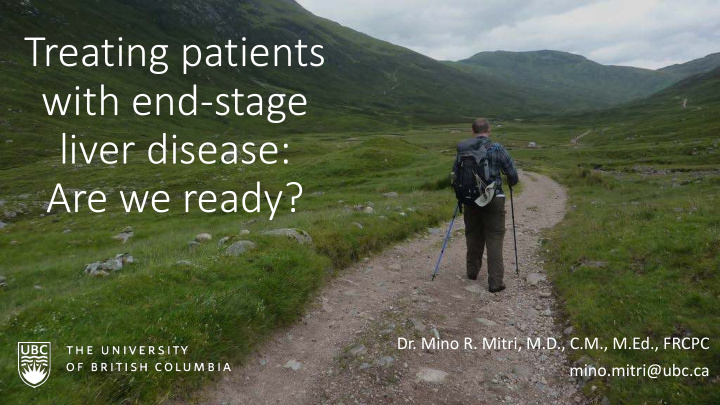



Treating patients with end-stage liver disease: Are we ready? Dr. Mino R. Mitri, M.D., C.M., M.Ed., FRCPC mino.mitri@ubc.ca
No Conflict of Interest
157 patients
157 6 patients transplanted
Criteria Liver Palliative Care Transplant Approach
Criteria Liver Palliative Care = Transplant Approach
“…advanced chronic liver disease when the limits of medical therapy have been reached.” AASLD 2013
“Patients should be selected if expected survival in the absence of transplantation is one year or less, or if the patient had an unacceptable quality of life because of liver disease.” EASL 2015
“Patients should be selected if expected survival in the absence of transplantation is one year or less, or if the patient had an unacceptable quality of life because of liver disease.” EASL 2015
“An a approach t that i improves t the q qua uality o of life of patients a and t their families f facing t the p problem associ ciated wi with life-threa eaten ening i illnes ess, t through t the prevention a and r relief o of suffering b by means o of early identification a and i impeccable a assessment a and treatment o of pain a and o other p problems, p physical, psychological a and s spiritual.”
Liver Palliative Transplant Care Patient with ESLD
Hawley, 2014
Hawley, 2014
Compensated Cirrhosis
Compensated Cirrhosis 6-12 years
Compensated Decompensated Cirrhosis Cirrhosis 6-12 years
Compensated Decompensated Cirrhosis Cirrhosis 6-12 years 2 years
Class Class Class A B C
1 year survival 100% 80% 45% Class Class Class A B C
Model for End-Stage Liver Disease (MELD) Score
15
20-25% Death
5-10% Clinical Deterioration
< 2 months
10%
“…well enough to undergo evaluation and listing, but sick enough to have developed signs of progression to a terminal state”. Fox, 2014
Liver Palliative Transplant Care Patient with ESLD
Liver + Palliative Transplant Care Patient with ESLD
Hawley, 2014
Treating patients with end-stage liver disease: Are we ready?
Treating patients with end-stage liver disease: Are we ready?
Patient Care
Patient Care ESLD
Patient Care Cancer ESLD
Ascites Cirrhotic Cardiomyopathy Gastroesophageal Varices Hepatic Encephalopathy Hepatic Hydrothorax Hepatocellular Carcinoma Hepatopulmonary Syndrome Hepatorenal Syndrome Portal Vein Thrombosis Portopulmonary hypertension Spontaneous Bacterial Peritonitis
Ascites Cirrhotic Cardiomyopathy Gastroesophageal Varices Hepatic Encephalopathy Hepatic Hydrothorax Hepatocellular Carcinoma Hepatopulmonary Syndrome Hepatorenal Syndrome Portal Vein Thrombosis Portopulmonary hypertension Spontaneous Bacterial Peritonitis
Portal Non-Portal vs Hypertension Hypertension
Portal Non-Portal vs Hypertension Hypertension
Spirinolactone 5:2 ratio Furosemide
Furosemide
X Furosemide
Spirinolactone 100mg : 40mg Furosemide
< 2gm / day
Large Volume Paracentesis (>5L)
6-8gm of Albumin per extra liter Large Volume Paracentesis (>5L)
Malignancy Cirrhosis
Malignancy Cirrhosis Peritoneovenous Shunting
Malignancy Cirrhosis Transjugular Peritoneovenous Intrahepatic Shunting Portosystemic Shunt (TIPS)
Portal Vein
Hepatic Vein Portal Vein
Ascites Cirrhotic Cardiomyopathy Gastroesophageal Varices Hepatic Encephalopathy Hepatic Hydrothorax Hepatocellular Carcinoma Hepatopulmonary Syndrome Hepatorenal Syndrome Portal Vein Thrombosis Portopulmonary hypertension Spontaneous Bacterial Peritonitis
Ammonia (NH3)
Bloodstream
Bloodstream Ammonia (NH3)
Bloodstream Ammonia (NH3)
Bloodstream Ammonia Ammonium (NH3) (NH4+)
Bloodstream Ammonia Ammonium (NH3) (NH4+)
Lactulose 30-45mL PO Bloodstream TID-QID Ammonia Ammonium (NH3) (NH4+)
Bloodstream Ammonia Ammonium (NH3) (NH4+)
Rifaximin 550mg PO Bloodstream BID or 400mg TID Ammonia Ammonium (NH3) (NH4+)
(Peng et al., 2018)
(Peng et al., 2018)
(Peng et al., 2018)
(Peng et al., 2018)
Always prescribe lactulose
Go REALLY low and REALLY slow
Opioids Codeine Tramadol Morphine Hydromorphone Oxycodone Fentanyl Methadone
Recommend
More recommend